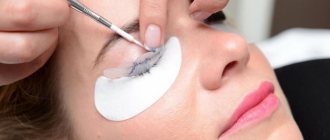The formation of swelling and bruising after surgical correction of the eyelids is the norm, due to the natural reaction of the human body to outside interference.
During the operation, the doctor touches the smallest capillaries and vessels with a surgical instrument. This leads to stagnant processes. Swelling reaches its peak 2-3 days after the procedure and then subsides. Injury to large vessels leads to bruising - red blood cells penetrate into the tissue along with lymph, coloring the surface layer of the skin in a bluish-purple hue.
Swelling may be accompanied by a feeling of pain and sand in the eyes - these are also normal variants.
How long does the swelling last?
Swelling may persist for 1-2 weeks. It happens that the rehabilitation process drags on for up to a month.
The duration of recovery is dictated by the following factors:
- Type of operation. Following extensive surgery (for example, blepharoplasty for Asian eyes), the face swells more. There are bruises. It takes 2 weeks for complete recovery. The seamless “Singapore” version is low-traumatic, so rehabilitation is faster;
- Patient's age. With age, tissue regeneration slows down, so postoperative injuries in people over 45 years of age take longer to heal. In addition, with obvious involutional changes inherent in adulthood, they are no longer limited to an isolated operation - they perform circular blepharoplasty, which, accordingly, is more traumatic;
- Features of the human body. With a tendency to stagnation and the proximity of blood vessels to the surface of the skin, bruises lighten more slowly;
- Skin thickness. Excessive skin density “holds” swelling longer than usual.
Reasons for appearance
The negative effect on the surface layer of the conjunctiva can be of a different nature, therefore the following conditions result from the appearance of chemosis:
- traumatic impact (foreign body, chemical or thermal burn, exposure to ultraviolet radiation, dust or dry air);
- allergies (house dust, plant pollen, animal dander);
- conjunctivitis is an infectious disease of the conjunctiva that is viral, bacterial, or fungal in nature;
- blepharitis - inflammation of the edges of the eyelids, which is formed due to infection with Demodex mites, viruses, bacteria, fungi;
- meibomitis - the formation of an abscess in the inner or outer part of the eyelid due to inflammation of the sebaceous glands;
- eyelid abscess - the formation of infiltrative purulent inflammation in a specific part of the eyelid, due to the limitation of the affected area;
- exophthalmos – displacement of the eyeball forward or to the side, most often considered a sign of serious diseases, ocular or systemic;
- vascular pathologies;
- tumors of the periorbital zone - swelling in the area of the eye orbit, which appears as a result not only of eye lesions, but also causes pathologies of the brain or the whole body;
- Chemosis can be a complication after blepharoplasty.
We recommend: How do scars heal after blepharoplasty?
This disease is considered a sign of serious eye problems and always requires serious examination and timely treatment. One of the most common causes of chemosis is considered to be allergic reactions, sometimes resulting from the uncontrolled use of medications.
How to relieve swelling after blepharoplasty?
Correct tactics of preparing for surgery will help you not only relieve postoperative swelling, but also prevent its severe severity. First of all, a week before blepharoplasty you should quit smoking and stop drinking alcohol. Be sure to stop taking any anticoagulants (blood thinning medications). Limit the amount of salt added to dishes - it tends to retain liquid in the tissues.
Qualified and experienced surgeons use atraumatic eyelid correction tactics that minimize complications.
In an interview, Vladislav Grigoryants shares his approach to performing the operation:
Start applying ice on the day of surgery, after the anesthesia wears off. Do not warm up the affected area under any circumstances and do not tilt your head down.
To reduce swelling, follow these simple rules:
- For the first 1-2 weeks, wash your hair like in a hairdresser - tilting it back
- Sleep on your back with a high pillow under your head, or better yet, half-sitting
- Do not smoke or drink alcohol (especially carbonated drinks - champagne, low-alcohol drinks, beer, etc.)
- Relax, rest and avoid physical labor
- Avoid activities that require constant blinking (spending long periods of time at the computer, watching TV, reading in low light, etc.)
- Maintain water balance without deviations in one direction or another
- Eat light and healthy foods
Description of the disease
The conjunctiva covers not only the eyeball, but also the inside of the eyelids, thus providing functionality to the eyes and providing them with the right amount of lubrication. That part of the conjunctiva that covers the fundus of the eye is called bulbar and consists of a superficial epithelial layer and a deep submucosal layer. When inflammation occurs, moisture begins to accumulate between the layers and swelling occurs.
In the area of the iris, the conjunctiva smoothly flows into the corneal layer. Here lies the border of the limbus, where the conjunctiva is firmly connected to the underlying tissue. Because of this, when chemosis appears, the conjunctiva protrudes above the surface of the fundus, and even difficulties arise when trying to close the eye.
What to apply to swelling?
From 3-4 days the doctor will prescribe you an antiseptic ointment.
Many experts advise patients to use the drug Traumeel systemically or locally. The product is really effective against edema. Sinyakoff ointment will help speed up the healing of bruises and at the same time disguise them.
After the wounds have healed, begin performing a gentle finger massage (light tapping) with Hydrocortisone or Contractubex. This measure will completely eliminate postoperative traces in the form of scars.
Physical therapy is a faithful assistant in the fight against such ailments. Microcurrent therapy is especially relevant.
Important reminder! Any treatment must be previously discussed with the surgeon. This is due to the fact that in some cases the use of the same drugs is acceptable, but in others it is not desirable. To avoid unpleasant complications, it is important not to self-medicate.
Signs
At the initial stage, it is quite difficult to identify pathology, since there are almost no external symptoms. Indeed, at this stage, the liquid between the layers of the conjunctiva is downloaded in small quantities, and only an ophthalmologist can detect it. As the process progresses, the patient's condition may worsen and symptoms may intensify:
- the appearance of discomfort in the eyes: pain, itching, burning;
- the appearance of blurred vision (blurred vision);
- the appearance of edematous phenomena may spread to the conjunctiva of the eyelids, in such a situation they close with difficulty and a feeling of pain;
- discharge from the eyes becomes purulent, as inflammation is most often accompanied by a bacterial infection;
- in the most severe situations, swelling spreads to both eyes. In this case, the impairment of the quality of vision becomes pronounced.
What should the patient do?
Usually, the contract concluded with the clinic mentions possible problems that may arise after the operation. And the doctor informs you about possible complications, and most importantly, talks about how everything should go normally. If the patient notices that the external post-operative signs are different, they should immediately go to their doctor. Most complications require his intervention, and possibly consultation and treatment with another specialist. Sometimes only a new operation can save you. In other cases, conservative treatment is sufficient for the same problem. For example:
- Massage and physiotherapy after blepharoplasty
Ectropion of the eyelid after blepharoplasty (eversion) can be eliminated with the help of special massage and gymnastics . Procedures and exercises increase the tone of the circular muscle of the optic organ, as a result of which the problem goes away. But these measures are not effective in all cases. Then the deficiency is corrected by suturing or repeat blepharoplasty. It is done no earlier than six months after the previous one.
- Dissatisfaction with the outcome of the intervention is resolved in different ways. Sometimes it is enough to expose the eyelids in the folds after blepharoplasty to a laser. Grinding or fractional thermolysis procedures are used. In other cases, only another operation will save you.
- Bleeding can be stopped by suturing the damaged vessel. And sometimes a puncture is enough to remove blood. If a vessel injury causes a retrobulbar hematoma, conservative treatment by an ophthalmologist, possibly surgery, is necessary.
- Scars after upper eyelid blepharoplasty, if they are too noticeable, can also be reduced to an acceptable appearance. For this, there are procedures for laser resurfacing, mesotherapy or fractional thermolysis. And sometimes using special creams is enough.
Possible complications
To eliminate the causes that provoked swelling and irritation, it is necessary to carry out comprehensive treatment. This may be the removal of an allergenic factor or the influence on pathogenic microflora, as well as the use of other restorative agents.
If it is not possible to eliminate the causes of chemosis after blepharoplasty or the treatment does not bring the desired result, then there may be a malnutrition of the corneal tissue with all the unpleasant consequences. Here, inflammation of the cornea (keratitis) of a non-infectious nature may develop in the presence of serious infections of a systemic nature (tuberculosis, syphilis).
Surgery
For moderate and mild diseases caused by chemosis (conjunctivitis, blepharitis, allergies), treatment is often performed using conservative methods at home. If serious complications occur, treatment in the clinic is possible.
But there is a list of conditions in which urgent surgical intervention is considered the only option for eliminating symptoms. These may be tumors in the orbital area, exophthalmos, the formation of internal barley, eyelid abscess and other pathologies.
Treatment with drugs
The use of medications for chemosis depends on the nature of the detected inflammation. Depending on the causes of infectious or non-infectious nature, drugs from the following groups can be used:
- antibiotics: Gentamicin, Tobramycin, Okamicin, Floxal. They are used topically, during the first few days up to 6-8 times; as symptoms decrease, the frequency of instillations is halved;
- antiviral: Indoxuridine, Poludan, Interferon alpha, Acyclovir. They can be used when the viral nature of the disease is detected and are very effective on the first day of infection;
- vasoconstrictors and antihistamines. The use of drugs in this group can bring positive results to eliminate symptoms of allergic damage to the conjunctiva, after eliminating the connection with the allergen.
Acyclovir
Taking medications is possible only after examination by an ophthalmologist and tests performed to diagnose the main disease.
Research
Prescription of the necessary treatment is carried out only after interviewing the patient, examining him and passing the necessary tests:
- laboratory tests (conjunctival scraping, bacteria test, blood test);
- ophthalmoscopy;
- biomicroscopy;
- visometry – identification of visual acuity;
- tonometry (measurement of intraocular pressure;
- special studies: ultrasound, CT, x-ray.
We recommend: Why do black circles appear after lower blepharoplasty?
Particular attention is paid to differential diagnosis, with the help of which it is possible to exclude such serious diseases as: abscess, tuberculosis of the skin and subcutaneous tissue, the presence of neoplasms, and in case of conjunctivitis, to determine the nature of the infection.











